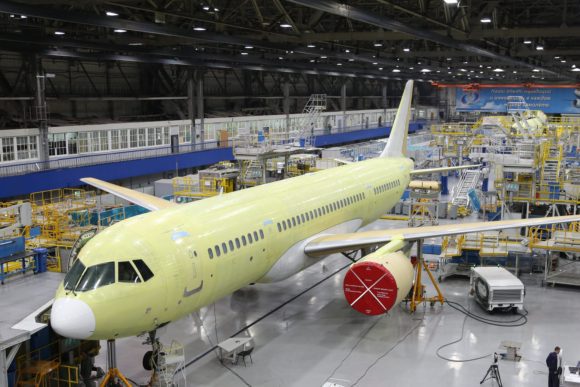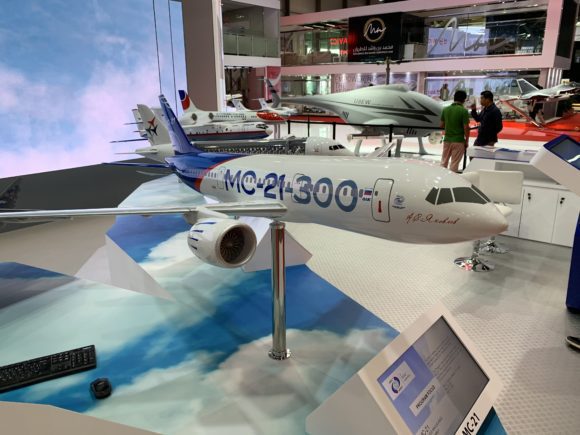Irkut announced the rollout of the third MC-21-300 aircraft yesterday, with the following statements:
“Irkut Corporation (a UAC member) completed construction of the third MC-21-300, intended for flight tests. On December 25, the aircraft was transferred from the final assembly shop to the flight test unit of Irkutsk aviation plant – a branch of Irkut Corporation.
Testing results of the first MC-21-300 aircraft passing certification tests were taken into account in the production of the new aircraft.
The components and units of the fourth flight test aircraft are being assembled at the Irkutsk Aviation Plant.
Currently, two MC-21-300 aircraft are taking part in flight certification tests at the airfield of Flight Test Institute named after M.M. Gromov.
The aircraft for static testing is tested in Central Aerohydrodynamic Institute (TsAGI). In December, the MC-21-300 aircraft fuselage was delivered here, which, after assembling the airframe, will join endurance tests.
President of UAC and Irkut Corporation Yuri Slusar said: “In 2018 flight and ground certification tests of aircraft prototype confirmed the main design solutions. UAC enterprises have begun to manufacture parts and units of MC-21-300 aircraft intended for customer’s delivery. Joining to the flight tests of new aircraft and production intensification of mass-produced airplanes are the main tasks of 2019. ”
“We can confidently say that 2018 turned out to be productive for the aircraft industry. Construction of the new aircraft and certification tests of the first aircraft confirm that the MC-21 program is developing steadily. As part of the program, a deep modernization of aircraft manufacturing enterprises was carried out, new high-tech companies were created, an environment for the development of perspective civil aviation projects was formed, ” – mentioned Denis Manturov, Minister of Industry and Trade of the Russian Federation.”
In this picture, we see #3 nearly ready to be towed out the FAL.
Then into the cold fresh air!
We followed up with a few questions to Irkut about their progress to date. Our questions were: How many days to assemble #1,#2 and now #3? Since #1 started flying, have there been any changes to the design? i.e. is #3 exactly the same as #1 and #2?
We got these answers within a few hours from a company spokesman.
- Assembly of the MC-21 aircraft at the Irkutsk plant is done using the same technologies that will be used to assemble aircraft during serial production. This allows easier transfer to mass production, although it increases the amount of work on initial stages. Now key assembly technologies are in place, workers have received all necessary training, logistics are in place as well. This allowed us to decrease the time needed to assemble the third aircraft by 40% compared to the first one.
- There are no major changes between the first, second and the third aircraft. However, the third aircraft has received minor changes as a result of ground and flight tests. This is normal practice while creating an absolutely new aircraft.
In our view, the rollout of the third example and the response to our questions suggests growing confidence at Irkut and UAC. Based on the 40% time decrease, the FAL’s team is well on their way down the learning curve. With each airframe completed, the time taken should continue to see improvements. Early production is planned at 20 per year, rising to 30. This suggests an initial 18 days per rollout dropping to 12 days.
For comparison purposes, Boeing is able to roll out a 737NG or MAX twice each day. Airbus is at roughly the same number. Which means Airbus and Boeing, at current rates, should have about 50 aircraft rolled out for every one MC-21 rolled out once Irkut has its FAL humming.
Bear in mind there are some aspects of production that are novel, such as the wing. Once the production processes are stabilized the FAL will settle into a steady production state. It appears Irkut is satisfied with its assembly procedures. It also seems Irkut is getting closer to its goal of industrializing the process. Given the planned production rate, the supply chain should be considerably less stressed than that of Airbus and Boeing.
Next #3 is acknowledged to already incorporate lessons from #1 and #2. This also demonstrates learning curve improvements. Irkut claims these updates are not “major changes”. Which should demonstrate the core design is working as expected. We think the changes may include software tweaks as the flight test program delivers growing insight into performance capabilities.
Views: 1






